Last Updated on January 23, 2024 by Greg Gillson
Did you see a brightly colored red bird, orange bird, or yellow bird in New Hampshire and wonder what it was?
This page is for you!
This article shows you photos and identification of some of the most common birds in New Hampshire based on color.
The list of birds found in New Hampshire includes over 420 species. So, I can’t show you all of them. I’m going to assume that you saw a common bird of this color, but you certainly could have seen something less common, or even rare!
Shape (including the shape of the bill) and size are often more helpful in starting to identify a bird than the color. In fact, most birds in North American can be easily identified with a black-and-white photo!
Many birds are multi-colored, so that it may be hard to pick out a dominant color. Males and females may be colored quite differently. And some color patterns are similar among otherwise dissimilar species.
Nevertheless, I’m going to try to pick out some of the birds that you are most likely to see in backyards or towns. And I’ll show a few others that I get asked about a lot.
The birds with a noticeable amount of red on them in New Hampshire covered in this article are:
- American Robin
- Northern Cardinal
- House Finch
- Purple Finch
- Ruby-throated Hummingbird
- Rose-breasted Grosbeak
- Common Redpoll
- Scarlet Tanager
The birds with a noticeable amount of orange on them in New Hampshire covered in this article are:
- Red-breasted Nuthatch
- American Redstart
- Barn Swallow
- Baltimore Oriole
- Wood Thrush
- Eastern Towhee
The birds with a noticeable amount of yellow on them, including lots of yellow and black birds, in New Hampshire covered in this article are:
- American Goldfinch
- Common Yellowthroat
- Yellow-rumped Warbler
- Cedar Waxwing
- Northern Flicker
- Pine Warbler
- Black-throated Green Warbler
- Yellow Warbler
- Pine Siskin
- Great Crested Flycatcher
- Magnolia Warbler
- Northern Parula
- Nashville Warbler
Red birds of New Hampshire
Birds get the red, orange, and yellow in their feathers from carotenoids in the fruit, seeds, and plants they eat (source).
These carotenoid colors combine with melanin to form an infinite range of red feathers–pink, rusty, scarlet, violet, red-orange.
The following are red birds that you are most likely to see in New Hampshire.
American Robin
These are familiar lawn birds with red breasts.
 |
| American Robin. Greg Gillson. |
Male American Robins are brownish-gray above with a brick red breast. Females are paler orange below and paler gray above.
They are widespread in open country with scattered deciduous trees, residential areas.
American Robins are year-round residents throughout New Hampshire.
Northern Cardinal
These are one of the most common backyard birds in the eastern United States. Their bright red color and unique head profile makes them instantly identifiable to most people–whether they are bird watchers or not!
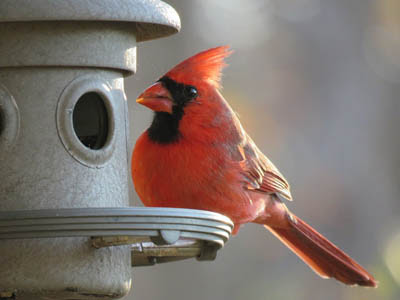 |
| Northern Cardinal. GeorgeB2 from Pixabay. |
Males of these large seed eaters are bright red with a black face and red crest.
Females replace most of the red with brown, The bill is large and orange.
These birds are found in woodlands, stream edges, residential areas.
Northern Cardinals are year-round residents in southern New Hampshire.
House Finch
When people ask about a bird with a red head at their feeder, it is usually this bird.
 |
| Male House Finch. Greg Gillson. |
Males of this dusty brown striped finch have red limited to the head (specifically the forehead and eyebrow), breast (chest), and rump. The red coloration tends toward orangish and may rarely be yellowish.
Females are streaked, similar to the males but without red. They lack any strong pattern on the face and head.
Note the small round head and curved upper ridge on the bill.
Some people call these red-headed sparrows. Sparrows and finches are similar, but in general, male finches are brighter than the females and tend to hang out more in trees. Sparrow genders are usually quite similar in coloration and tend to feed mostly on the ground.
These birds are common in residential areas, especially at bird feeders. In the West more widespread in arid regions near water.
House Finches are year-round residents throughout New Hampshire.
Purple Finch
Forest finches of the foothills, delicately frosted in pinkish-red.
 |
| Male Purple Finch. Greg Gillson. |
Told from more common House Finch by bigger square or peaked head, bigger bill, lacks sharp striping below, deeply notched tail. Red covers all plumage.
Females lack red color, shows strongly patterned dark ear patch outlined all around with a pale stripe, is heavily streaked below.
Found in foothills and damp mountains conifers and mixed woods. Visit feeders, but less frequently than House Finches.
Purple Finches are year-round residents throughout New Hampshire.
Ruby-throated Hummingbird
These red-throated birds are the only hummingbird nesting in the eastern United States.

Males are dark green above and on the belly. They have a white upper chest. The throat is ruby-red.
Females are green above, white below, including white throat.
These birds are found in woodland edges, residential yards. Readily come to hummingbird feeders.
Ruby-throated Hummingbirds are summer residents throughout New Hampshire.
Rose-breasted Grosbeak
These birds with the red breast and huge pink bill sing beautiful robin-like songs from the tops of trees.
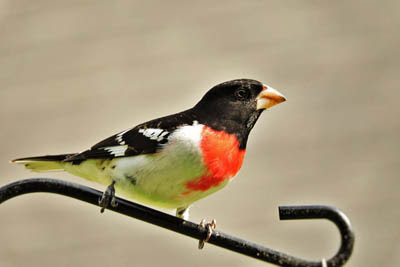 |
| Male Rose-breasted Grosbeak. Susan Killian. Pixabay. |
Males have black hood and upper parts. White under parts. Large white wing patches. Huge pink bill. Inverted bright red triangle on the breast.
Females are brown above, face with broad stripes, white throat. The under parts are buff with many thin brown streaks. Pale bill.
These birds inhabit deciduous and mixed forests. Shade trees in town. Come to feeders.
Rose-breasted Grosbeaks are summer residents throughout New Hampshire.
Common Redpoll
These frosty pink and red birds are northern relatives of the goldfinches.
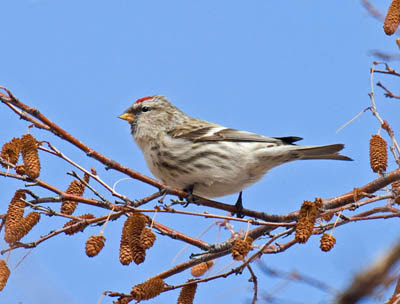 |
| Common Redpoll. Greg Gillson. |
These birds are frosty white in winter with brown striping above and on the sides. Both genders have red caps, black around bill and chin. Adult males have red upper breast. Immatures less red.
These birds are found in weedy fields and alder and birch trees in winter. Come to thistle feeders.
Common Redpolls are winter visitors throughout New Hampshire.
Scarlet Tanager
A brilliant red and black bird!
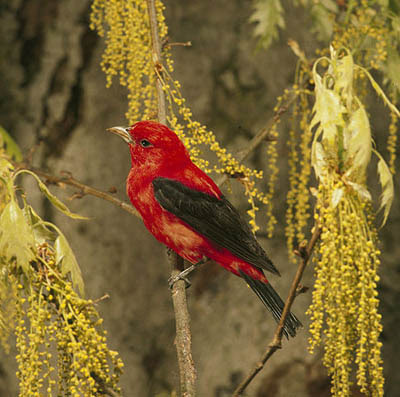 |
| Male Scarlet Tanager. USF&WS. Public Domain. |
Males are unmistakable with brilliant red with black wings and tail.
Females are olive-green above, darker wings and tail, yellower under parts. Pale bill.
These birds live in deciduous woods.
Scarlet Tanagers are summer residents throughout New Hampshire.
Orange birds of New Hampshire
True orange-colored birds are not that common. Many birds that I have here are paler rusty.
The common pattern is an orange body and black or brown wings and tail. Another common pattern is for the orange to be restricted to the under parts.
The following are orange birds that you are most likely to see in New Hampshire.
Red-breasted Nuthatch
These active little red-breasted birds crawls all around on the trunk and big branches of conifers. They search crevices in the bark for insect food.
 |
| Red-breasted Nuthatch. Greg Gillson. |
These tiny birds have blue-gray backs and a black line through a white face. Some males can have quite bright rusty red under parts. Some females can have quite pale buff-colored under parts. Most birds show an orange-cinnamon breast color.
Found nearly exclusively in conifers. Readily come to feeders.
Red-breasted Nuthatches are year-round residents throughout New Hampshire.
American Redstart
In flight these small warblers flash orange or yellow in the wing and base of the tail.
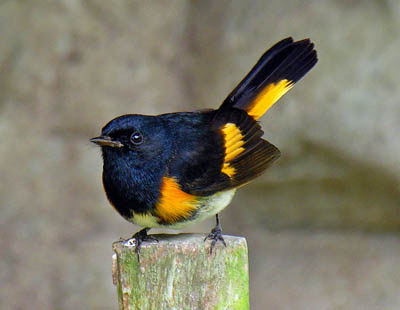 |
| American Redstart. Dennis Jarvis. Flikr. CC BY-SA 2.0 |
Males are black above, white on the belly. They have bright orange patches on side of breast, wings, and base of the tail.
Females are grayer, especially on the head. The orange of males is replaced by yellow on the females.
These birds are found in regenerating woods after a clear cut, and willow tangles along streams.
American Redstarts are summer residents throughout New Hampshire.
Barn Swallow
These orange-bellied birds are a familiar sight across North America in summer.
 |
| Barn Swallow. Greg Gillson. |
These birds are purple-blue above with orange under parts and long forked tails. The color of the underparts in winter or on females are often cinnamon or buff-colored, but breeding males can be brighter orange-red.
These birds swoop low over fields and wetlands at lower elevations. They may build their mud nests in rafters on porches, garages, or other out-buildings.
Barn Swallows are summer residents throughout New Hampshire.
Baltimore Oriole
These bright orange and black birds are fairly common breeders in wooded areas in the East.
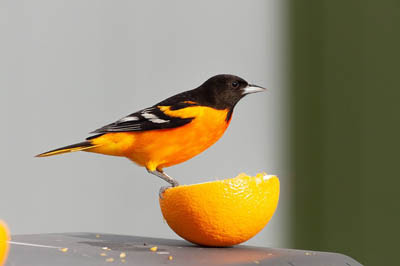 |
| Baltimore Oriole. Michael McGough. Pixabay. |
Males have a black hood and back. Wings black with white patches. Tail black with orange sides to the base. Bright orange under parts.
Females are similar to males, but more olive above, less black. Immature birds for their first year or more are olive above orangish-yellow on the breast, fading to yellow on the belly. Two white wing bars.
These birds are common in deciduous woods, shade trees.
Baltimore Orioles are summer residents throughout New Hampshire.
Wood Thrush
These spotted birds with the orange-brown upper parts tend to hide in understory trees and on the forest floor.
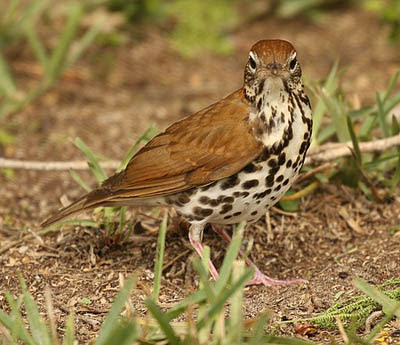 |
| Wood Thrush. Tony Castro. CC BY-SA 4.0 |
These birds are reddish brown on the upper parts, especially rusty orange on the crown and upper back. White eye ring. Large heavy black spots on the under parts.
They live in deciduous and mixed woods. Spend much time on the ground, shuffling through the leaf litter.
Wood Thrushes are summer residents throughout New Hampshire.
Eastern Towhee
These birds with rusty-orange sides like to hide in dense bushes.
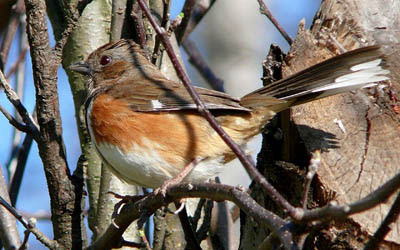 |
| Female Eastern Towhee. Skeeze. Pixabay. |
Males are black above with white wing patch, white tail corners. The sides are rusty. The belly white. Eyes variable: brown, red, orange, white, tending toward whiter southward.
Females are similar, but upper parts brown.
These birds are found in forest understory, dense brush, backyard hedges. Come to feeders.
Eastern Towhees are summer residents throughout New Hampshire.
Yellow birds of New Hampshire
Yellow is a common bird color! Often it is mixed with black and white plumage in birds.
Many birds with darker upper parts have yellow breast or belly.
The following are yellow birds you are most likely to see in New Hampshire.
American Goldfinch
These small little birds are bright yellow and black.
 |
| American Goldfinch. Greg Gillson. |
Males are bright lemon yellow with black and white wings and tail, black cap. White under tail coverts. Pink bill.
Females are duller yellow below and brownish above. Lack black cap.
Winter birds are pale brown or gray, a touch of yellow on the throat of males.
These are birds of open country, fields with saplings, clear cuts, residential areas. They avoid dense forests, mountains, deserts. They visit feeders.
American Goldfinches are year-round residents throughout New Hampshire.
Common Yellowthroat
These buttery yellow birds are abundant in the marsh vegetation.
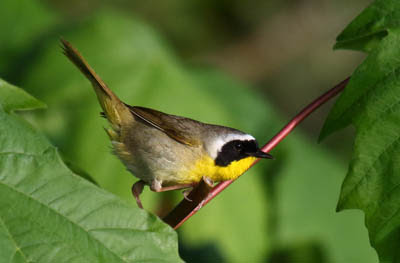 |
| Male Common Yellowthroat. Greg Gillson. |
These skulkers have bright yellow throats and yellow undertail coverts. Males have a black domino mask edged broadly in white, which females lack. Upperparts are dull olive-green.
Immature males in fall show a shadowed black mask.
Found in damp situations and heavy deciduous brambles following clear cuts.
Common Yellowthroats are summer residents throughout New Hampshire.
Yellow-rumped Warbler
These are abundant warblers across North America. Affectionately called “butter butts” by many birders, because of their bright yellow rumps that flash in flight.
 |
| Myrtle Yellow-rumped Warbler. Greg Gillson. |
Western form (Audubon’s) with bright yellow throat and yellow rump. Large white wing patch.
Northern and Eastern form (Myrtle) with white throat, yellow rump, and two white wing bars.
Winter birds are dull gray-brown, with bright yellow rump. Throat may be cream colored or white. Often difficult to tell the two forms apart in winter.
 |
| Winter Yellow-rumped Warbler. Greg Gillson. |
Breed in mountain or boreal conifers. Widespread in migration. Winter in low river bottoms, open weedy deciduous areas. Rarely come to feeders in winter.
Yellow-rumped Warblers are summer residents throughout New Hampshire.
Cedar Waxwing
These crested birds with yellow band on the end of the tail are often found in flocks. They eat flying insects in summer, fruit and berries the rest of the year.
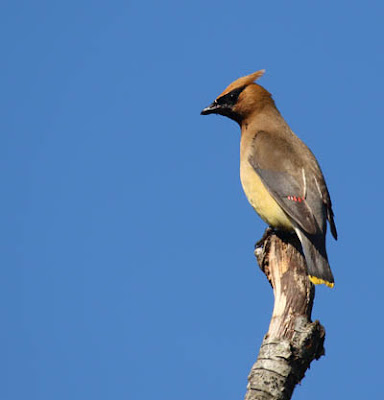 |
| Cedar Waxwing. Greg Gillson. |
These birds are fawn-brown above, with dark gray wings and tail. They have a black mask and wispy crest. The belly is yellow. The wings have waxy red drops on the end of the tertials. The end of the tail has a brilliant yellow tail band.
They are found in open habitats with berries, including juniper woodlands and towns in winter.
Cedar Waxwings are year-round residents throughout New Hampshire.
Northern Flicker
These woodpeckers spend much time eating ants on the ground.
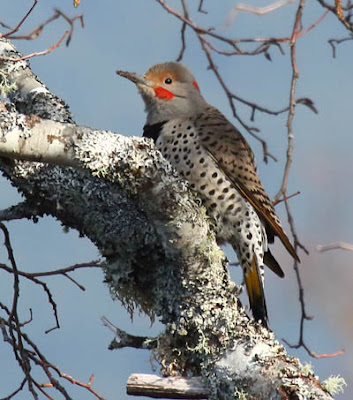 |
| Northern Flicker. Greg Gillson. |
These birds are larger than robins with brown and black barred upper parts. The underparts are pink with round black spots. There is a black crescent across the chest. When they fly away from you they reveal a large white rump.
Western birds have salmon-red under wings and under tail. Those in the East are colored yellow. The male face differs between the two populations–black whisker on the eastern birds, red whisker on western birds. Intergrades from overlap on Great Plains common. These may show male facial characteristics of both populations, or yellow-orange flight feathers.
These birds live in open woods with bare ground for foraging, residential yards.
Northern Flickers year-round residents throughout New Hampshire.
Pine Warbler
This yellow and gray bird is one of the few warblers to visit feeders–and the only one to eat seeds!
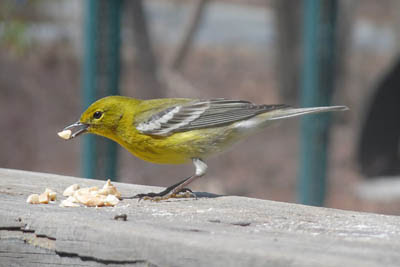 |
| Pine Warbler. Nikolaus Schultz. Pixabay. |
These birds are yellow-green on head, back, and breast. Wings blue-gray with wide white wing bars. Yellow split eye ring.
Strongly associated with pine forests. Usually high in treetops.
Pine Warblers are summer residents throughout New Hampshire.
Black-throated Green Warbler
Look for these birds with the yellow faces singing high up in the trees in spring.

Males in spring have green back and crown, black throat, circling a bright yellow face.
Females and immatures in fall have a white throat. Greenish ear patch.
Found in many forest types, conifers, mixed forests, and cypress.
Black-throated Green Warblers are summer residents throughtout New Hampshire.
Yellow Warbler
The golden yellow sun packed all into one little bird! Appears to be an all-yellow bird.
 |
| Yellow Warbler. Greg Gillson. |
Some populations are bright yellow, some tend toward greenish on upper parts, some more golden. Yellow internal tail corners in flight.
Males with red breast streaking, again, variable by population.
Females somewhat, to much, paler yellow, some greenish, some whitish. Lack red streaks.
These birds are found in willow thickets on the edge of wetlands and ditches, stream sides in arid regions.
Yellow Warblers are summer residents throughout New Hampshire.
Pine Siskin
These small brown-streaked birds are relatives of the goldfinches. But you would never know it until they fly and sport yellow wing stripes and tail base. Usually in flocks.
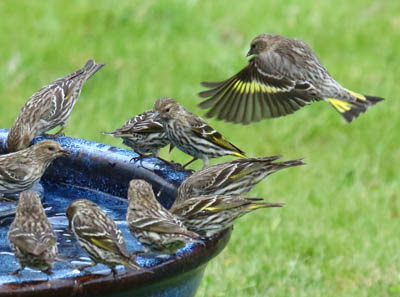 |
| Pine Siskin. Greg Gillson. |
These birds are streaked brown. In flight they have a yellow stripe down the length of the wing. The sides of the base of the tail are also yellow. Some birds are paler, some darker, others brighter yellow, others duller.
These birds are found in summer in northern conifer woods. Irregularly irrupt hundreds of miles southward. Frequent at feeders.
Pine Siskins are winter visitors throughout New Hampshire, year-round residents in northern New Hampshire.
Great Crested Flycatcher
These flycatchers have long tails and big heads with big bill and bright yellow belly.
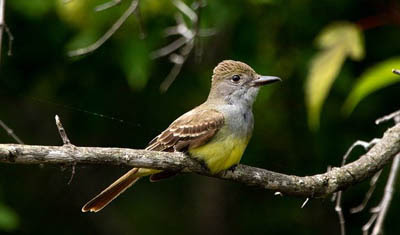 |
| Great Crested Flycatcher. Simard Francois. Pixabay. |
These birds are gray on the face and breast, brownish on rest of upper parts. Bright lemon-yellow belly. The underside of the tail and some feathers of the wing is cinnamon colored.
These birds stay in the canopy of open woods.
Great Crested Flycatchers are summer residents throughout New Hampshire.
Magnolia Warbler
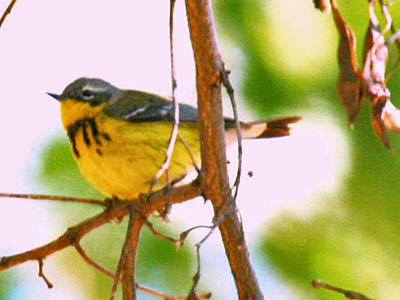 |
| Magnolia Warbler. Greg Gillson. |
Adult males are gray and black above and bright yellow below. Black mask and lower face. Gray crown. Black upper back. Black necklace that breaks into streaks down the breast. White under tail coverts. White under tail base, black terminal tail feathers. Large white wing patch.
Female with two wing bars, black mostly replaced with olive. Immatures for the first year lack black markings.
Live in moist coniferous forests, young stands of spruce and hemlock.
Magnolia Warblers are summer residents throughout New Hampshire.
Northern Parula
This is a handsome blue and yellow warbler.

Males are blue on the hood and shoulders. Back green. Yellow throat and breast with a dark red spot mid-chest. Broken white eye ring. Two wide white wing bars.
Females are similar, but paler.
They are found along streams and in swampy forests with willows, maples, birches, hemlocks and other trees.
Northern Parulas are summer residents in central and northern New Hampshire, spring and fall migrants only in southern New Hampshire.
Nashville Warbler
These birds with the bright yellow underparts do a good job of hiding!
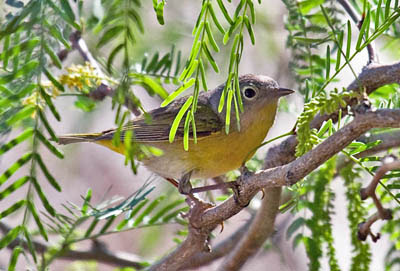 |
| Nashville Warbler. Greg Gillson. |
These birds are gray above. The throat and breast and under tail coverts are bright lemon yellow. The belly is white. They have a complete white eye ring.
Females are just a bit paler than males.
These birds are found in re-growing clear cuts, and understory brush in open woods.
Nashville Warblers are summer residents throughout New Hampshire.
Wrapping Up
New Hampshire is home to many colorful birds but they are not limited to red, orange and yellow. There are many others though and some of my favorites range from black and white, to blue and green. Here are my favorites:
Blue Jay: This iconic New Hampshire bird features vibrant blue plumage with a white chest and black markings on its head and wings. They are known for their loud, vocal calls and bold personalities.
Eastern Bluebird: Smaller than the Blue Jay, the Eastern Bluebird is a beloved songbird with vibrant blue coloring on the male and a softer blue-gray on the female. They favor open woodlands and backyards with nesting boxes.
Cedar Waxwing: These gregarious birds have a unique crest and a mix of brown, gray, and yellow plumage. However, they stand out for their vibrant red wing tips and bright yellow tail band. You can often find them feasting on berries in flocks.
Black-capped Chickadee: This adorable, year-round resident has a black cap and bib contrasting with its gray back and white underparts. While not predominantly blue or green, its overall color scheme fits the theme and its charming demeanor makes it a favorite.
Black-throated Blue Warbler: This stunning warbler frequents coniferous forests during the breeding season. The male boasts a vibrant black throat and blue wings, while the female has a duller plumage with hints of blue.
Cerulean Warbler: This dazzling blue warbler visits New Hampshire for breeding but is uncommon. Males are a brilliant sky-blue with black wings and markings, while females are greenish-yellow with blue wings.
Indigo Bunting: These small songbirds sport a stunning deep blue plumage on the male, contrasting with the female’s brown coloring. They favor open fields and brushy areas during the summer months.
Frequently Asked Questions
Where can I find a Scarlet Tanager in New Hampshire?
The Scarlet Tanager is a stunning bird, but finding it in New Hampshire can be a bit of a challenge. Here’s what you need to know:
They breed in deciduous and mixed deciduous/coniferous forests, favoring mature trees with open canopies. Look for oak woodlands, particularly in hilly areas. While primarily forest birds, they may occasionally be found in heavily wooded suburban areas.
They are migratory birds, arriving in New Hampshire in late April to early May and leaving in late August to September. Your best chance to spot them is during the breeding season.
What is the bright orange bird in New Hampshire?
The most likely candidate for the “bright orange bird” in New Hampshire is the Baltimore Oriole. Here’s why:
- Coloration: Male Baltimore Orioles are unmistakable with their vibrant orange breast and shoulder patch, contrasting sharply with their black head, back, wings, and tail. Females, while less flashy, still have a dull yellow-orange front, making them stand out from other birds.
- Prevalence: Baltimore Orioles are common summer residents throughout New Hampshire. They frequent open woodlands, edges of forests, and even backyards with trees, readily attracted to feeders offering nectar and fruit.
- Seasonality: This is crucial! You mentioned seeing the bird in late January. While Baltimore Orioles overwinter in southern United States and Mexico, some rarely linger in sheltered areas of New Hampshire during mild winters. However, seeing one in January is highly uncommon.
What is a yellow bird with black wings in New Hampshire?

The American Goldfinch actually has black on its wings year-round, but the extent and visibility of this black coloration can change depending on the season and age of the bird:
Breeding Season (Spring & Early Summer):
- Males: During this time, they sport their most vibrant plumage, characterized by a bright yellow body with a black cap and black wings with white wing bars. The black on their wings is prominent and easily visible.
- Females: They have duller plumage, lacking the black cap but still showing brownish wings with buffy edges that appear somewhat dark.
Non-Breeding Season (Fall & Winter):
- Both sexes: They undergo a molt and acquire a duller, brownish plumage. While the black on their wings remains, it becomes less prominent due to the overall drab coloration. Additionally, the white wing bars become fainter or disappear altogether.
- Juveniles: They have brownish upperparts with cinnamon-buff wing markings that can appear somewhat dark compared to their pale underparts. However, their wings lack the distinct black and white pattern of adult males.
Related Articles:
Most common backyard birds in New Hampshire
Birds with red heads in North America.
Yellow-and-black birds in North America.










